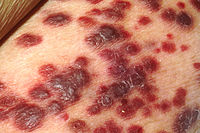
Photo from wikipedia
Kaposi’s sarcoma-associated herpesvirus (KSHV) causes the inflammatory and angiogenic endothelial cell neoplasm, Kaposi’s sarcoma (KS). We previously demonstrated that expression of the KSHV protein, Kaposin B (KapB), promoted inflammation via… Click to show full abstract
Kaposi’s sarcoma-associated herpesvirus (KSHV) causes the inflammatory and angiogenic endothelial cell neoplasm, Kaposi’s sarcoma (KS). We previously demonstrated that expression of the KSHV protein, Kaposin B (KapB), promoted inflammation via the disassembly of cytoplasmic ribonucleoprotein granules called processing bodies (PBs). Processing bodies (PBs) modify gene expression by silencing or degrading labile messenger RNAs (mRNAs) including many transcripts that encode inflammatory or angiogenic proteins that are associated with KS disease. Although our work implicated PB disassembly as one of the causes of inflammation during KSHV infection, the precise mechanism used by KapB to elicit PB disassembly was unclear. Here we reveal a new connection between the degradative process of autophagy and PB disassembly. We show that both latent KSHV infection and KapB expression enhanced autophagic flux via the phosphorylation of the autophagy regulatory protein, Beclin 1. KapB was necessary for this effect, as infection with a recombinant virus that does not express the KapB protein did not induce Beclin 1 phosphorylation or autophagic flux. Moreover, we reveal that PB disassembly mediated by KSHV or KapB depended on canonical autophagy genes and the selective autophagy receptor NDP52/CALCOCO2 and that the PB scaffolding protein, Pat1b, co-immunoprecipitated with NDP52. These studies reveal a new role for autophagy and the selective autophagy receptor NDP52 in promoting PB turnover and the concomitant synthesis of inflammatory molecules during KSHV infection. Author Summary Kaposi’s sarcoma-associated herpesvirus (KSHV) is the causative agent of the inflammatory, endothelial cell cancer, Kaposi’s Sarcoma (KS). KSHV induces a pro-tumourigenic inflammatory environment which aids in the establishment and maintenance of the KS lesion. Processing bodies (PBs) are cellular structures that dampen inflammatory gene expression by suppression or decay of their cognate RNA molecules. We previously showed that the viral protein KapB caused PB disappearance during KSHV infection, identifying a new pathway used by KSHV to elicit inflammation. Now, we show that KSHV and KapB hijack the cellular degradative process of autophagy to promote PB disassembly and increase inflammatory gene expression. This places autophagy as central to the regulation of inflammation by KSHV and illustrates another remarkable strategy used by these viruses to create a tumourigenic microenvironment.
Journal Title: PLOS Pathogens
Year Published: 2022
Link to full text (if available)
Share on Social Media: Sign Up to like & get
recommendations!